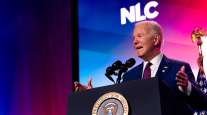Opinion: Restore Nonpartisan Support for Infrastructure
Support for infrastructure historically has been a nonpartisan issue, both in the halls of Congress and in cities, towns and counties across the nation. Across every level of government, construction of roads, bridges, highways — including the interstates — airports, water and wastewater treatment facilities increasingly brought levels of infrastructure service up and user costs down. Interstate commerce exploded, raising living standards and boosting consumer confidence. For elected officials, it was easy and fun to support infrastructure.

Miller
Perhaps the most significant example of nonpartisan support for state infrastructure came in 1956, when Congress authorized $70 billion for the interstate highway grant program. State highway departments got an offer few could refuse: for every $10 a state spent on the initial design and construction of the 40,000-mile interstate highway network, Congress would reimburse $9.
Federal money flowed to every state — and every Senate and House district. Construction of America’s high-speed road network was accelerated, a one-time federal shot in the arm that improved movement of goods, people and information.
Through it all, infrastructure remained a state and local issue. Even today, nearly all of the nation’s vehicle miles traveled occur on state or local highways and streets, and most bridges are owned by state and local governments. Congress has never been in the business of owning or operating the nation’s infrastructure assets.
But since the days when the interstate system was born, two changes have made this classic style of nonpartisanship impossible.
First, state and local infrastructure assets have aged. Deferred maintenance backlogs are high, and infrastructure is in poor shape. State and local governments are not meeting commitments — made when grants were given — to adequately maintain this infrastructure. For every dollar spent on design, at least $10 is spent on construction, and at least $100 is spent on operation, maintenance and repair over the asset’s life. In the case of the interstate system, the infusion of money at the front end got things moving, but that federal funding for 90% of the first $11 left state and local governments with a liability 10 times the cost of initial construction.
Second, urban and rural infrastructure needs are increasingly asymmetric. In densely populated areas, wireless, broadband, GPS and telecommunications networks are entirely private, with a strong user base, while rural areas lag behind in coverage and service quality. In transportation, the situation is flipped. The cost of rebuilding/extending rural infrastructure is comparatively low, while urban costs are notoriously high. Boston’s $14 billion Big Dig and the proposed $32 billion New York City Gateway Project are recent examples.
The mechanisms of the 1950s for funding and managing the nation’s infrastructure have become entirely ineffective. Congress has frozen the process from the top. Cities, towns, counties, and states make their infrastructure plans with one eye over their shoulder – on Congress –for discretionary construction grants that history has shown produce future operating liabilities many times the amount of that grant.
Countries in the developed world are shifting away from grants for new construction toward Enterprise Risk Management — a logistics-based lifecycle approach focused on meeting network levels of service commitments at competitively verified prices.
This approach has been formalized into a written international standard — ISO-31000 (En-2009) — to track and perform yearly programs of effective maintenance, repair and replacement activities across an entire infrastructure network: at the right time, in the right place, and at a competitively verified price. This standard is a good example of how Congress should work with state governments to solve infrastructure problems.
State goals would be straightforward: meet level-of-service commitments to users and budget commitments to Congress and perform planned activities — on deadline — at a competitive verified cost.
ERM logic fits well within established networks. Our research at MIT confirmed it produces lifecycle cost savings of 30% to 40% by extending facility life and responding logically to ongoing maintenance and repair needs — rather than reflexively through years of deferred maintenance and decay until new construction is the only alternative. Open procurement practices are an important part of the equation, allowing owners to match materials, equipment and services to activities. To date, ERM has been successfully adopted in Australia, Canada, England, Scotland and Holland.
To restore nonpartisan support for infrastructure, Congress must shelve its practice of new construction grants and offer in its place, long-term, stable, grant funding to states — contingent only on adoption of best practices in procurement and recognized proven practices for enterprise risk management.
It’s time for Congress to challenge itself to change and once again make infrastructure a nonpartisan issue.
John Brown Miller is an elected fellow of the American Bar Association’s Section of Public Contract Law and is an expert on infrastructure procurement. He was a professor of civil engineering at MIT. Barchan Foundation’s mission is to help governments take practical steps to develop solutions to infrastructure problems that produce higher levels of service at lower lifecycle cost.




